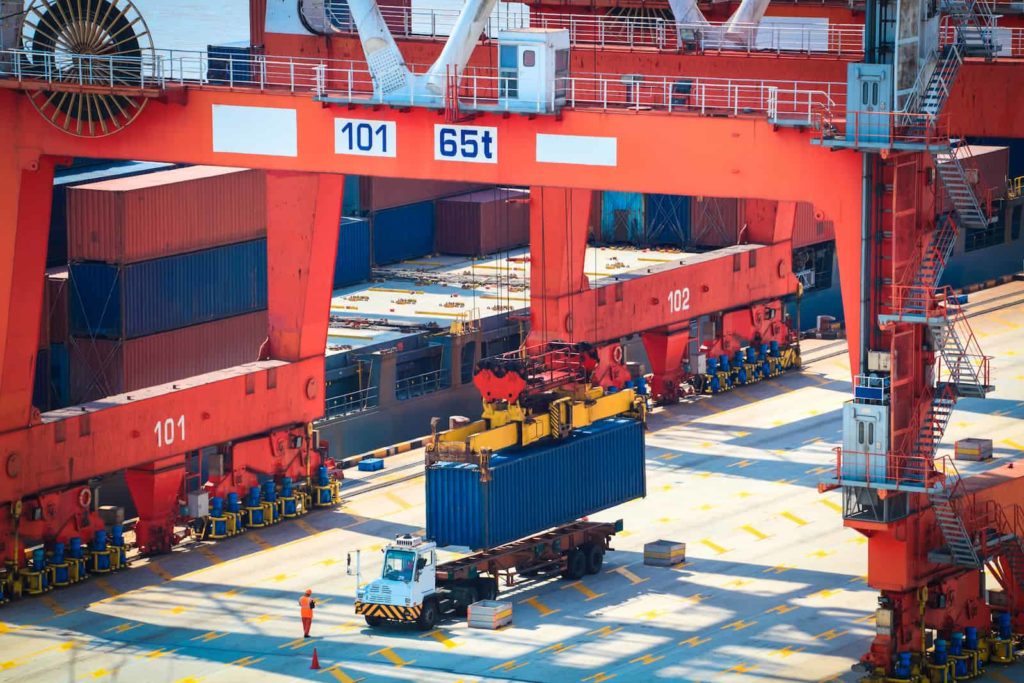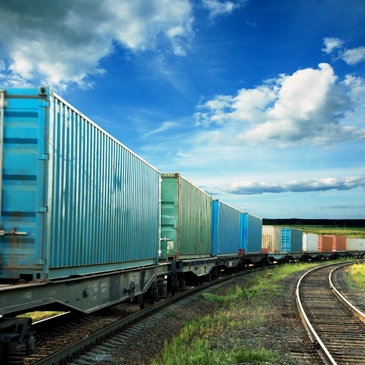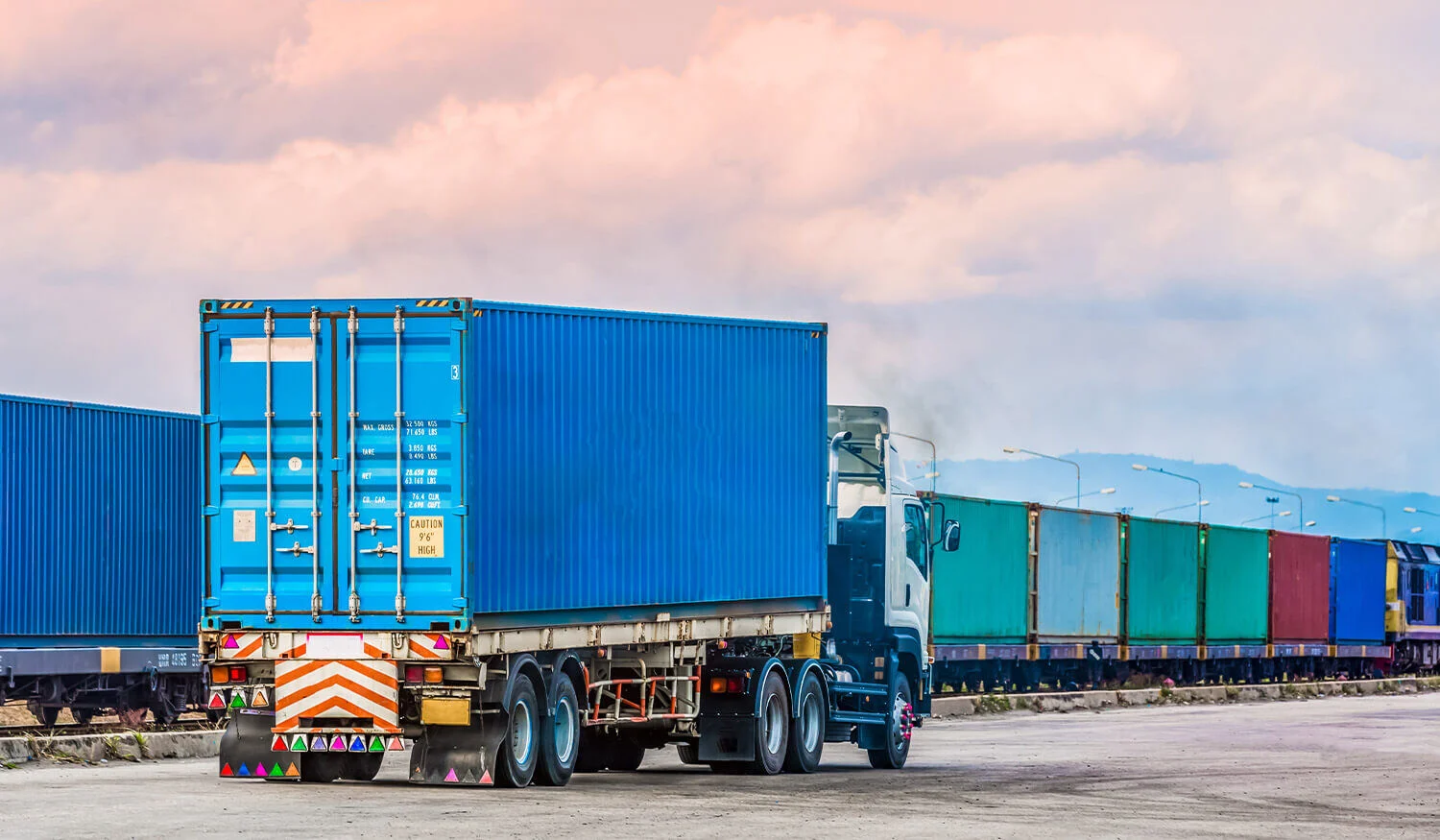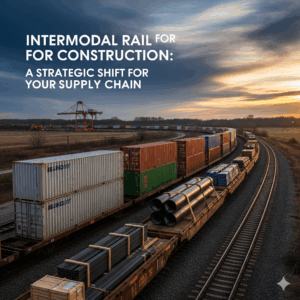In today’s globalized supply chain, the question “What is intermodal logistics?” has become increasingly important for businesses seeking to streamline their shipping operations, reduce costs, and improve sustainability. At its core, intermodal logistics refers to the coordinated use of multiple modes of transportation—most commonly rail, truck, and ocean shipping—to move goods from origin to destination in a single, seamless journey. This system relies heavily on standardized intermodal containers that can be transferred between modes without handling the cargo itself, significantly reducing delays and risks associated with traditional freight movement.
But intermodal logistics is more than just a combination of trains and trucks. It represents a highly strategic, technology-driven logistics model that optimizes every leg of the journey. In 2025, where supply chain resilience, speed, and sustainability are essential, understanding what intermodal logistics is—and how it benefits your business—is key to staying competitive.
Breaking Down the Term: What Is Intermodal Logistics, Really?
To truly understand what intermodal logistics means, let’s break down the term:
- Intermodal refers to the use of two or more different modes of transportation in a single freight journey. For example, a shipment might travel by truck to a rail terminal, then by train across the country, and then by truck again to reach its final destination.
- Logistics encompasses the planning, execution, and management of moving goods across the supply chain efficiently.
When combined, intermodal logistics involves coordinating trucks, trains, ships, containers, and supporting infrastructure into one cohesive freight strategy. It requires careful planning of routes, equipment, and transfer points—but the payoff is big: lower costs, higher reliability, and better environmental performance.
Why Is Intermodal Logistics So Relevant in 2025?
As supply chains become more complex and customer expectations more demanding, the pressure is on to move goods faster, more predictably, and with lower emissions. This is where intermodal logistics shines. If you’re asking “What is intermodal logistics and why does it matter?”, here are some of the 2025 realities driving its adoption:
- Rising fuel and labour costs in trucking
- Driver shortages across North America
- Congestion at ports and highways
- Corporate ESG goals requiring reduced carbon emissions
- Digitization and visibility tools making intermodal more manageable
- Government investment in rail and intermodal infrastructure
With intermodal logistics, shippers can adapt to these pressures by building more resilient, flexible, and cost-efficient freight networks.
How Intermodal Logistics Works: A Simple Example
To illustrate what intermodal logistics is in action, consider this common Canadian scenario:
- A container full of manufactured parts is picked up by a truck in Calgary.
- It’s delivered to a nearby intermodal rail terminal.
- From there, the container is loaded onto a railcar and transported to Toronto.
- In Toronto, the container is transferred back to a truck.
- The truck completes the “last mile” delivery to a factory in Mississauga.
At no point is the cargo inside the container unpacked or touched. This hands-off, intermodal movement ensures speed, security, and efficiency from origin to destination.
Core Components of Intermodal Logistics
To understand what intermodal logistics entails operationally, it’s important to recognize its key building blocks:
1. Intermodal Containers
Standardized containers—usually 20’, 40’, or 53’ in length—allow seamless transfer between trucks, trains, and ships.
2. Rail Networks
Canada’s rail infrastructure is the backbone of intermodal logistics. Trains move large volumes of freight long distances with high fuel efficiency.
3. Trucking for First and Last Mile
While rail covers the long haul, trucks handle local pickups and deliveries to and from intermodal terminals.
4. Intermodal Terminals
Facilities where containers are loaded or unloaded between modes—equipped with cranes, storage yards, and scheduling software.
5. Digital Logistics Platforms
Advanced software enables real-time tracking, load optimization, predictive delays, and automated paperwork across the entire intermodal chain.
These components work in harmony to make intermodal logistics the agile, scalable freight solution businesses are turning to in 2025.
The Strategic Benefits of Intermodal Logistics
If you’re still asking “What is intermodal logistics good for?”, consider the following strategic advantages:
✅ Cost Savings
Rail is significantly more cost-effective than trucking over long distances. When you incorporate rail into your logistics plan through intermodal solutions, you reduce fuel costs, tolls, and driver expenses.
✅ Environmental Impact
One train can move a ton of freight over 400 km on a single litre of fuel. Using intermodal logistics helps companies reduce their greenhouse gas emissions and meet sustainability targets.
✅ Scalability and Flexibility
Intermodal logistics works for both small LTL shipments and massive FCL loads. It can scale up or down based on your volume and can adapt to market changes quickly.
✅ Cargo Security
Containers are sealed and locked from origin to destination. With less handling and fewer transfers, there’s a reduced risk of theft, damage, or loss.
✅ Predictability and Reliability
Rail transport is less vulnerable to road congestion and driver availability issues. Intermodal routes offer consistent transit times, especially across high-volume corridors.
Who Should Use Intermodal Logistics?
Now that we’ve answered the question “What is intermodal logistics?”, let’s explore who should use it. Intermodal logistics is a strong fit for:
- Manufacturers shipping between provinces or cross-border
- Retailers needing consistent restocking
- E-commerce companies managing regional distribution
- Agriculture and food producers requiring reefer or dry container solutions
- Energy and industrial suppliers with heavy or oversized freight
- Any business with large volumes, long distances, or cost concerns
Whether you’re a small business or an enterprise shipper, intermodal logistics can be tailored to meet your needs.
Canada’s Growing Intermodal Ecosystem
In Canada, intermodal logistics has grown exponentially over the past decade—and in 2025, it’s more powerful than ever. Rail lines operated by CN and CP, intermodal terminals in major hubs like Toronto, Vancouver, Calgary, and Montreal, and increased port access make intermodal an integral part of national freight strategy.
Canada’s geography—vast distances, concentrated metro regions, and access to the U.S. border—makes it ideal for intermodal shipping. Companies that embrace this model gain not only cost efficiency but also a competitive advantage in service delivery.
Why Understanding Intermodal Logistics Matters Now
To succeed in 2025, businesses need to think beyond traditional trucking. Understanding what intermodal logistics is allows you to explore new freight strategies that balance speed, cost, sustainability, and resilience. As supply chains become smarter and greener, intermodal logistics isn’t just an option—it’s becoming the industry standard.
What is Intermodal Logistics?
Intermodal freight refers to goods and raw materials transported within standardized containers across various modes of transport. These containers, often adhering to International Organization for Standardization (ISO) dimensions, allow for seamless transfer between ships, trucks, and trains without requiring the contents to be moved into new containers. This efficient system optimizes transportation and reduces handling risks.

The Intermodal Logistics Process
The intermodal logistics process starts with an empty truck arriving at the shipper’s location. The cargo is then securely loaded into a standardized container placed on the truck. Notably, this cargo often remains untouched within the container until it reaches its final destination.
The truck transports the container to a rail yard via the road network. Here, the container is transferred to a train for rest of the transportation. The train may deliver the container directly to a rail terminal in the destination city or transport it to a seaport for oceanic shipping.
Upon reaching the destination port, the container is unloaded and transferred to another truck or train for inland transportation. This final leg of the journey, often referred to as drayage, is typically handled by specialized trucking companies.
Once the container arrives at its final destination, the cargo is removed, and the empty container is prepared for its next shipment. The final delivery of the goods to the end consumer is known as the last mile and is typically completed by the logistics provider.
The primary advantage of intermodal logistics lies in its ability to leverage the strengths of different transportation modes. As rail transportation is generally cost-effective for long distances within a country, while shipping excels in covering vast international distances. Trucks are really important for getting things to and from places that are close by. They are also used to move things between different cities.
The Advantages And Disadvantages Of Intermodal Logistics
Intermodal logistics has become the backbone of the trade and logistics industry due to its numerous benefits. However, like any transportation method, it presents challenges. Let’s explore the advantages and disadvantages of intermodal logistics.
Advantages
- Rapid service:
Intermodal logistics often reduces delivery times by utilizing the fastest mode of transportation for each leg of the journey. Efficient container transfer between modes also contributes to faster deliveries.
- Lower costs:
By combining different transportation modes, companies can benefit from lower overall shipping costs, including reduced handling expenses. Additionally, rail transportation, a common component of intermodal logistics, is generally more fuel-efficient than trucking, leading to cost savings.
- Increased capacity:
The widespread use of intermodal logistics allows businesses to achieve economies of scale and increase capacity. Additionally, reverse logistics can optimize container utilization.
- Safety:
Goods remain securely sealed within containers throughout the transportation process, minimizing the risk of damage, theft, and unauthorized access.
- Eco-friendliness:
Intermodal logistics, particularly the use of rail, reduces carbon emissions compared to traditional trucking, making it a more environmentally friendly option.
Disadvantages
- Structural costs:
The efficiency of intermodal logistics can be impacted by factors such as container weight and the availability of suitable infrastructure, especially in developing countries. These elements can increase costs.
- Delays:
While intermodal logistics often offers faster transit times, delays can occur due to factors such as indirect rail routes, congestion at transfer points, and weather conditions.
- Reliability:
The involvement of multiple transportation modes and carriers increases the potential for disruptions and delays. Careful coordination is essential to mitigate risks.
By carefully considering the advantages and disadvantages of intermodal logistics and aligning it with specific transportation needs, businesses can optimize their supply chain operations and achieve improved efficiency, cost-effectiveness, and sustainability.
The Rise of Inermodal Logistics
Intermodal transport is a rapidly expanding industry. While specific Canadian data on container and trailer movements may vary, it is evident according to reports that this mode of transportation is experiencing significant growth globally. More than 20 million intermodal containers are currently in use worldwide. Intermodal transport has gained widespread adoption due to its efficiency, cost-effectiveness, enhanced security, and expedited delivery times. As international trade and infrastructure development progress, the demand for intermodal transport is anticipated to increase substantially.
Technological advancements are driving the evolution of intermodal transport. The growing online retail sector, coupled with the transportation industry’s shift towards digital operations, has created a favorable environment for intermodal services. The ability to efficiently manage digital records further enhances the appeal of intermodal transport.
Is Intermodal And Multi-Modal Transport Same?

Intermodal and multimodal transport are often confused due to their shared use of multiple shipping methods to deliver goods. While intermodal transport is a type of multimodal transport, a key distinction lies in the handling of the cargo. In intermodal transport, the goods remain sealed within the same container throughout the entire journey, without being unpacked or transferred.
This standardized container ensures the safety of the shipment. In contrast, multimodal transport might move the goods between different containers or vehicles. The containers used in multimodal transport can be different sizes and types.
Here is a table to better visualize ta whole comparison –
| Characteristic | Intermodal Transport | Multimodal Transport |
| Mode of transport | Two or more | Two or more |
| Change of load unit during transit | No | Yes |
| Load unit | Standardized | Non-standardized |
| Management of Cargo | Entrusted to a single operator | Entrusted to multiple operators |
Conclusion
Why Intermodal Logistics Is the Smarter, Stronger, and More Sustainable Choice in 2025
As we wrap up our deep dive into the question “What is intermodal logistics?”, it’s clear that this shipping strategy is no longer a niche solution—it’s the backbone of modern freight transportation in 2025. The combination of multiple transportation modes—typically truck, rail, and sometimes ocean—offers unmatched advantages in cost efficiency, cargo security, sustainability, and scalability. And with advanced tracking technologies, smarter intermodal terminals, and expanding infrastructure across North America, intermodal logistics is positioned to drive the next era of resilient, high-performance supply chains.
Whether you’re a mid-sized manufacturer in Ontario or a national retailer with distribution centres across Canada and the U.S., the choice to embrace intermodal logistics in 2025 is more than a matter of efficiency—it’s a strategic move toward long-term success.
Recap: What Is Intermodal Logistics—And Why Does It Matter?
If you’ve ever asked yourself, “What is intermodal logistics and how does it apply to my business?”, here’s a summary of what we’ve explored:
- Intermodal logistics is the use of more than one transportation mode in a single freight movement, typically involving standardized containers that remain sealed throughout the journey.
- It reduces cargo handling, minimizes damage risk, and makes long-distance shipping more affordable.
- It capitalizes on the fuel efficiency of rail, the flexibility of trucks, and the cost savings of containerized movement.
- It is driven by digital tools that provide visibility, track shipments in real-time, and optimize delivery schedules.
- In 2025, it plays a critical role in helping businesses meet ESG goals, navigate driver shortages, and build resilient supply chain networks.
For companies asking not just “What is intermodal logistics?” but also “How can I scale with it?”, the answer lies in the strategic application of this freight model to improve cost control, enhance customer service, and future-proof operations.
Top Benefits Revisited: What Makes Intermodal Logistics So Valuable in 2025?
Let’s revisit the major benefits that answer the core question—what is intermodal logistics capable of delivering?
🚛 Lower Costs, Higher Value
Intermodal logistics reduces the reliance on long-haul trucking, which is expensive due to fuel costs, insurance, and driver wages. Rail transport is significantly more economical per tonne-kilometer. That cost advantage directly impacts your bottom line—especially for businesses shipping over 500 miles.
🌱 Environmentally Responsible Shipping
One of the biggest draws of intermodal logistics in 2025 is its role in sustainable freight. Rail shipping produces fewer emissions per ton than road freight, and optimized load planning means fewer empty miles. For companies with sustainability mandates or carbon-reduction targets, intermodal logistics is one of the most effective ways to make measurable progress.
🔐 Increased Freight Security
With containers sealed at origin and not opened until destination, cargo moves with minimal handling—reducing risks of theft, loss, or damage. This secure chain-of-custody is a major reason why sensitive and high-value shipments rely on intermodal logistics as their preferred freight method.
📦 Capacity and Flexibility
Intermodal logistics helps you avoid the driver shortage and limited truck availability that many Canadian shippers face. Rail can move more goods faster across long distances, and the intermodal system flexes to absorb seasonal spikes or capacity bottlenecks more easily than truck-only systems.
🔍 Real-Time Visibility and Control
With the growth of smart containers, GPS-enabled railcars, and digital freight platforms, intermodal logistics today is fully trackable. Shippers benefit from data transparency, automated status updates, and predictive ETAs—allowing them to make better, faster decisions.
The Role of Intermodal Logistics in Canadian and Cross-Border Shipping
Canada’s unique geography and trade position make it an ideal use case for intermodal logistics. With vast distances between major cities, strong Class I rail networks (CN and CP), and well-established intermodal terminals in cities like Toronto, Vancouver, Calgary, and Montreal, Canadian businesses have direct access to a robust intermodal ecosystem.
And when it comes to cross-border trade, intermodal logistics is an even bigger advantage. Shipments that originate in Ontario or Quebec can be loaded into containers, moved by rail across the U.S., and then completed by truck in destinations like Chicago, Dallas, or Atlanta—all with a single point of coordination.
If you’re asking “What is intermodal logistics doing to simplify international shipping?”—the answer is: everything. From seamless customs processing to integrated North American rail corridors, intermodal shipping makes global logistics more manageable, predictable, and cost-efficient.
Barriers to Adoption—And How to Overcome Them
For companies new to the concept and still wondering “What is intermodal logistics going to require from me?”, it’s normal to have some hesitation. Common barriers include:
- Lack of in-house expertise
- Misconceptions about speed or flexibility
- Concerns about infrastructure access
- Limited knowledge of intermodal routing
The good news? These barriers are easily overcome with the right logistics partner. Firms like RailGateway specialize in building tailored intermodal strategies that align with your shipment volumes, delivery schedules, and budget goals—without requiring your team to become freight experts.
Looking Ahead: What Is Intermodal Logistics Becoming?
Intermodal logistics isn’t static—it’s evolving. In 2025 and beyond, intermodal shipping will continue to benefit from:
- 5G-powered real-time tracking systems
- AI-based route optimization and load balancing
- Blockchain-based digital documentation
- Expanded electrified rail corridors and green railcars
- Government policies favouring low-emission transportation
As these technologies and policies mature, intermodal logistics will become even more powerful—enabling smarter, faster, cleaner, and more accountable freight movement across the entire supply chain.
Final Thoughts: Why Understanding What Intermodal Logistics Is Matters Now More Than Ever
To summarize: understanding what intermodal logistics is—and embracing it—is no longer optional for forward-thinking Canadian businesses. It’s a strategic imperative.
As costs rise, emissions regulations tighten, and customer expectations grow, traditional trucking models alone can’t keep up. Intermodal logistics gives you the agility, efficiency, and resilience to adapt and thrive. From small B2B shippers to large multi-channel retailers, this model offers a path to smarter, more profitable operations.
So if you’ve been asking “What is intermodal logistics and should I be using it?”, the answer in 2025 is a definitive yes.
🚆 Get Started with Intermodal Logistics Today
Want to explore how intermodal logistics could lower your freight costs and scale your operations across Canada and the U.S.?
Partner with Canada’s intermodal experts at RailGateway.
We help businesses of all sizes unlock the benefits of intermodal rail shipping—without the stress, confusion, or delays. From container sourcing to route planning, we handle the details so you can focus on growth.
📞 Visit railgateway.ca or contact our logistics team to request your custom intermodal quote today.

FAQ’s
1. What is intermodal?
Intermodal logistics is the strategic use of two or more modes of transportation—typically truck and rail—to move freight in a single, continuous journey. The cargo remains in one intermodal container throughout transit, reducing handling, improving efficiency, and lowering costs.
2. How does intermodal work?
A typical intermodal logistics route starts with a truck picking up a container from the shipper and delivering it to a rail terminal. The container is then moved by train over long distances. At the destination terminal, another truck completes the final delivery. The cargo inside the container is not handled or repacked at any point.
3. Why is intermodal important in 2025?
In 2025, businesses are facing rising trucking costs, tighter environmental regulations, and increasing pressure to optimize operations. Intermodal logistics offers a powerful solution by combining the cost-efficiency of rail with the flexibility of trucking. It also supports sustainability goals by significantly reducing emissions.
4. Is intermodal faster than truck-only shipping?
Not always—but it can be more predictable and reliable, especially for long-haul freight. While rail may take slightly longer in some corridors, it avoids traffic congestion, driver shortages, and other common trucking delays. Plus, intermodal routes can be more consistent in transit times, particularly across Canada and into the U.S.
5. What types of freight are suitable for intermodal shipments?
Intermodal logistics is ideal for freight that is:
- Palletized or containerized
- Not extremely time-sensitive
- Traveling over 500 km (especially cross-country or cross-border)
- Full truckload (FTL), although LTL is increasingly supported
- Non-perishable or temperature-controlled (via reefer containers)
6. Can small businesses use intermodal logistics?
Yes. While intermodal was once used mostly by large shippers, modern logistics providers make it accessible for small and mid-sized businesses. With third-party logistics partners or intermodal brokers, companies of all sizes can benefit from cost savings and scalable freight options.
7. How much money can intermodal logistics save?
On average, businesses can save 15% to 25% on long-haul freight costs compared to full truckload shipping. Exact savings depend on route, container availability, fuel surcharges, and volume. Intermodal logistics is particularly cost-effective on major corridors like Toronto–Vancouver, Montreal–Calgary, or cross-border routes to U.S. hubs.
8. Is intermodal logistics environmentally friendly?
Yes—intermodal rail shipping significantly reduces carbon emissions. Trains can move 1 ton of freight over 400+ km using just 1 litre of fuel. Companies that adopt intermodal logistics often see a measurable improvement in their environmental footprint, helping them meet corporate sustainability goals.
9. How do I track freight in intermodal logistics?
Modern intermodal logistics solutions include real-time tracking through GPS-enabled containers, railcar monitoring, and digital transportation management systems (TMS). Shippers can view shipment status, estimated delivery times, and exceptions through centralized dashboards.
10. How do I get started with intermodal logistics in Canada?
Start by partnering with an experienced intermodal logistics provider like RailGateway. They can evaluate your shipping needs, recommend routes, handle container coordination, and manage truck-rail transfers. The process is surprisingly easy—with big returns in cost savings and efficiency.





